Monkey Wrench follows the sci-fi adventures of Shrike and Beebs, a mercenary duo crossing the galaxy as they hunt for gigs. Created by Josh and Ashley Palmer, the interstellar series combines Josh’s experience as an engineer with their mutual love of science fiction, comedy, and anime.
As an indie YouTube series with a dedicated cult following, the show is a labour of love for the Palmers. Josh, a self-taught animator, does about half of the production himself and employs as many freelance animators as the project’s Patreon will allow.
We had a chance to sit down with Josh Palmer to discuss passion projects, the viability of crowdfunding, and the realities of producing an indie animated series.
You’re a full time freelance animator?
Josh: Yep, I’ve been doing it for almost seventeen years now. I’m surprised I’m still going!
I’m sure you’ve seen a lot of changes in the industry over that time.
Josh: Oh yeah, a lot of changes. When I first started, the very early versions of Toon Boom Studio and Flash had just come out. Digital art was still a new frontier.
I do a lot of stuff on Newgrounds and DeviantArt. I can always remember the stigma of people being like, “Digital art is not real. You’ve got to use pencils and paper. You’ve got to animate on paper.” Just seeing how the times have changed and how everything’s moved over to digital has been really interesting. Makes me feel really old.
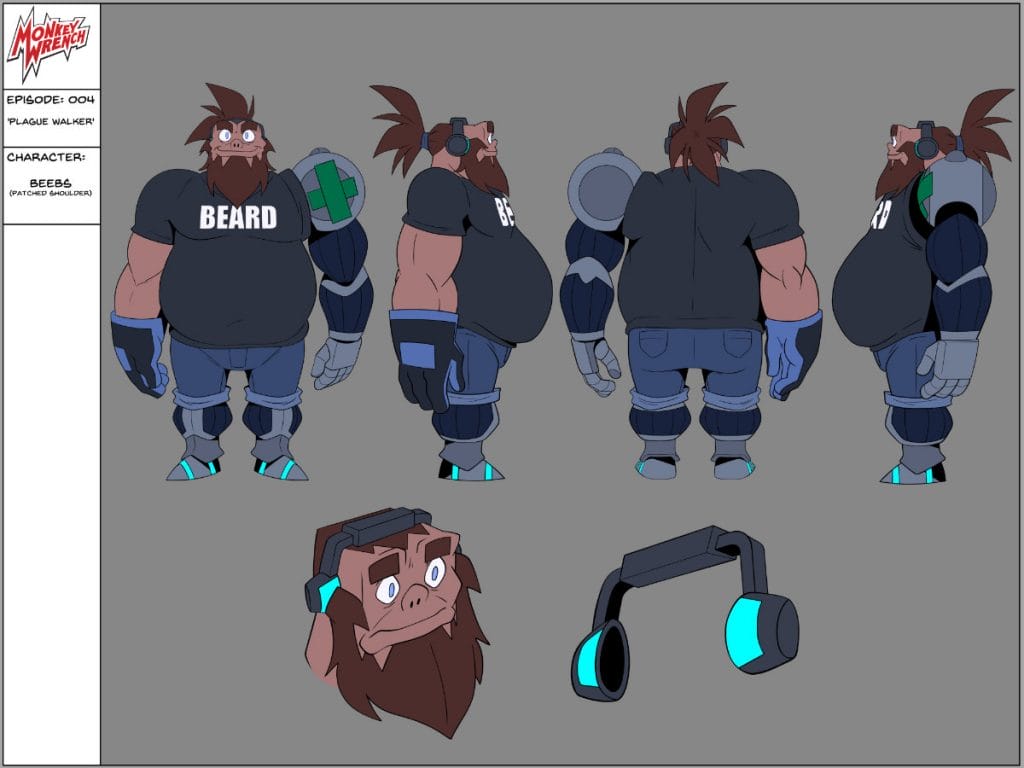
Is there a medium that you prefer? And did starting with a more traditional pipeline inform how you use software like Harmony?
Josh: When I first started out, animation wasn’t my main thing. I was a mechanical engineer. So I’d always do art on the side, like mechanical drawings and little comics and doodles. And my father was a graphics design teacher. He’d always have spare exercise books that you could write and draw in.
Digital is so much easier for me, personally, because all the tools are there. If you make a mistake, it’s easy to fix it up. The brushes are right there on the computer. You don’t have to reach over or find one or have to buy a new one. It’s just a lot more convenient.
It’s interesting that you mentioned you have a mechanical engineering background. I think that informs Monkey Wrench. It’s a sci-fi series, and there’s all this futuristic tech everywhere.
Josh: I’ve always loved sci-fi and just mechanical things in general. I grew up watching old 90s anime stuff. That was still new at the time as well, getting imported and dubbed. Shows like Outlaw Star, Cyber City Odeo 808 and, dare I say, Angel Cop as well. Just all the old 90s stuff, as well as Tank Police.
And I’m just always fascinated with the mechanical details, especially stuff in Mobile Suit Gundam, Neon Genesis Evangelion and that. And just trying to use that kind of stuff in my own work. I just love animating detail.
As you might be able to see, [comparing] episode one of Monkey Wrench to episode three, you can see how things have been really complicated and then moved over to be a bit more simple. I love doing complex, detailed stuff, but my crew might not. I don’t want to put anyone through unnecessary detail strain, trying to make sure all these details are exact, when the characters are moving around.
And that is always the compromise, right? Whether it’s for stylistic purposes or just for practicality in production. How do we cartoonify this concept visually? What details do we keep? What details do we remove?

You mentioned your crew. So what’s your role on the production? And who are some of the other key players? I know it’s also written by your partner.
Josh: Yeah, it’s written by me and my wife. To keep costs down, I do all the storyboarding. I do all the character designs. I do all the backgrounds. I do at least 50% to 60% of the episode myself, in terms of rough animation and cleanup.
And what we can afford, we hire people out to give us a hand. I think on episode four right now, we’re halfway done and we have about forty people helping out. So we have about twenty rough animators and twenty cleanup animators to give us a hand.
Is this a side project for everybody involved?
Josh: Pretty much, yes. I would love to get to a point where I can hire people and pay them weekly or give them a yearly salary. That would be awesome.
Right now, I’m paying them via our Patreon support. That’s how we get most of our money. Then there’s merch sales and me doing freelance jobs on the side to help pay people to work on this at the same time.
As far as I know, [the animators are] all freelancers just like me. They have themselves all dotted around other projects. A couple of them that work on Monkey Wrench are also working on Far-Fetched or Lackadaisy. It’s neat how the indie animation sphere is very tight-knit as well. You’ll find all sorts of animators working on all different projects.

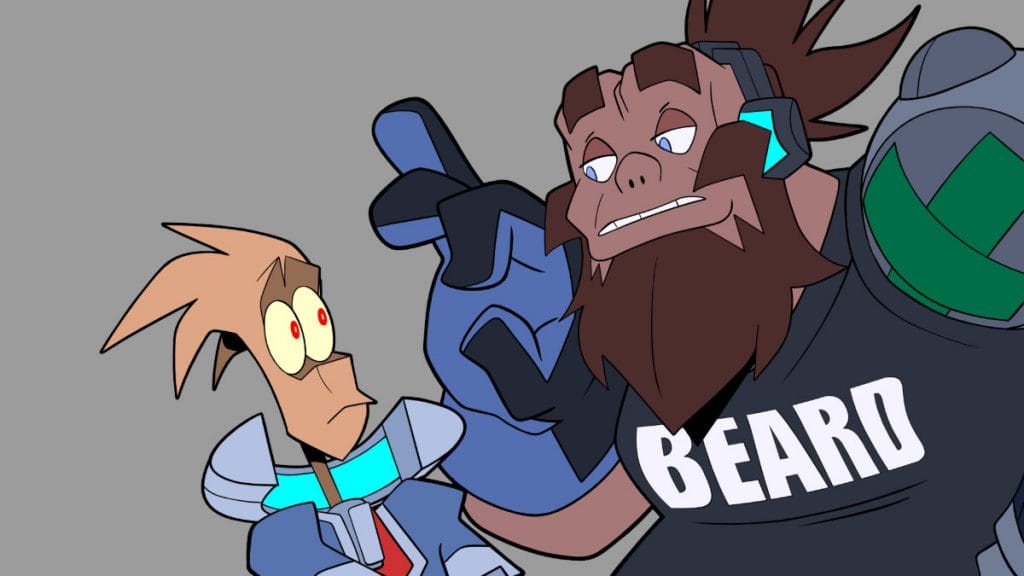
We’ve been seeing so many awesome projects come out as people are saying, “I have the time. I’m going to make something I’m passionate about.”
Josh: I always try and be as down to earth, as honest with people as possible. My wife and I are very open with our supporters about where the money is going on our production.
It’s incredibly hard to get the money to be able to fund everything. The money, unfortunately, is the lifeblood of these indie shows. And I don’t want to put a downer on anything, but there are a lot of kids out there that are watching these indie shows come out, like Lackadaisy and The Amazing Digital Circus, and saying, “I want to do that too.”
But they’ve got to remember, out of all the indie animated shows out there, there’s maybe four or five that have hit the big time that can continue to be successful. There are so many others that are struggling and failing to get initial funding goals, attention, and all that stuff. It’s very, very difficult.
That’s the theme that I hear in basically every professional production: the balance between creativity and the bottom line. So how do you guys walk that tightrope? What do you compromise on?
Josh: Well, I’m very fortunate in the fact that we do have quite substantial Patreon support right now. So I can have maybe ten to fifteen minutes of an episode animated by our crew. But it’s mostly a human cost for me. I’m fine with sacrificing my time to work on this stuff. I’m super lucky to be able to do most of it myself.
I’m known to be incredibly fast, and that’s only because I don’t really rough out scenes. I just go straight into cleanup. I’ll only rough out stuff if it really needs to be roughed out, so I can get the scene just right. I usually get about twelve to fifteen seconds of frame-by-frame done a day. It’s crazy.
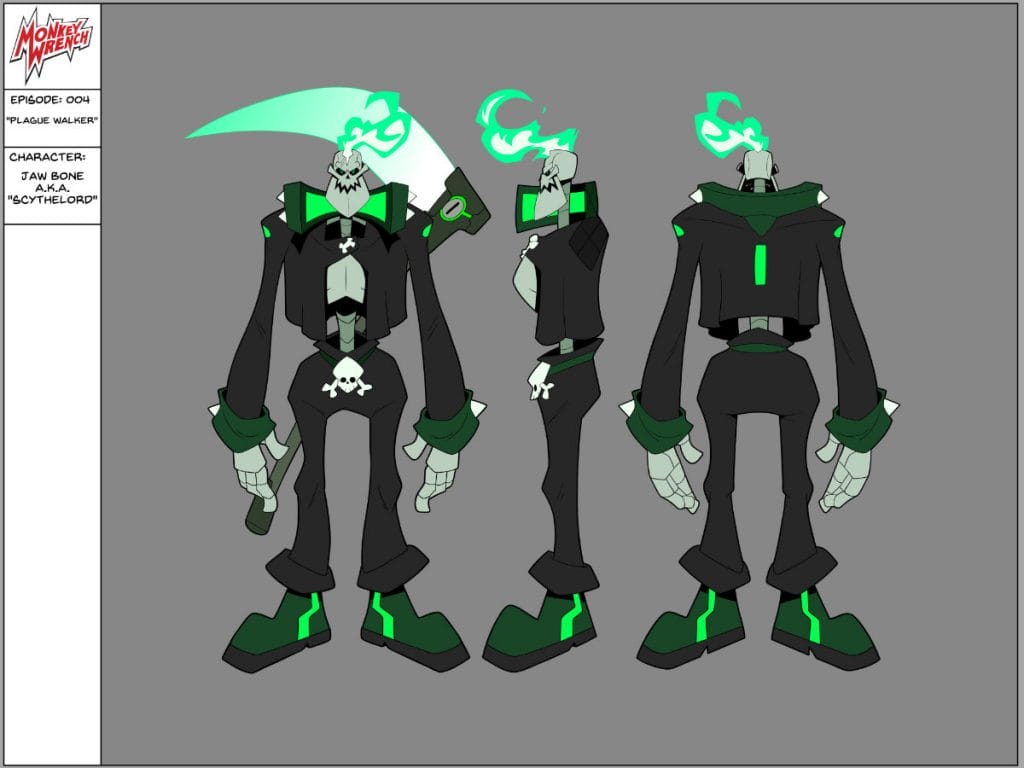
And I noticed on Monkey Wrench, the character designs are awesome and fairly easy to replicate. And the character animation has a stylized choppiness to it.
Josh: Yeah. When I started out doing animation, I was always like, “Okay, animation’s gotta be on ones and twos all the time. It’s gotta look really smooth and really flowy.” But animation really is just a medium to tell a story.
And if you look at anime, a lot of them get away with animating on fours and fives, and sometimes even sixes. It really is all down to the timing and the spacing of your frames. And Keeping it on threes and fours, again, helped us keep the cost down. Or two, it just helps it speed things along. It makes it visually more interesting, I think.
You use Harmony for Monkey Wrench. Do you also use Storyboard Pro?
Josh: I do not. I’m weird when I do my storyboards. I only storyboard once I have all the audio together. I like to storyboard to the inflections because I find it helps me visualize better what I want the scene to be.
So once I have all the audio out, I blot out, say, two minutes of audio for a scene. I actually import that into Toon Boom Harmony itself and then I just do a very basic storyboard, animatic kind of animation to go with it. Because if I do that, there’s a lot less messing around with having to go back and change things.
If I can technically animate it in the animatic how I want it, my crew instantly gets what I’m after. And they can just go ahead and get it done that way.
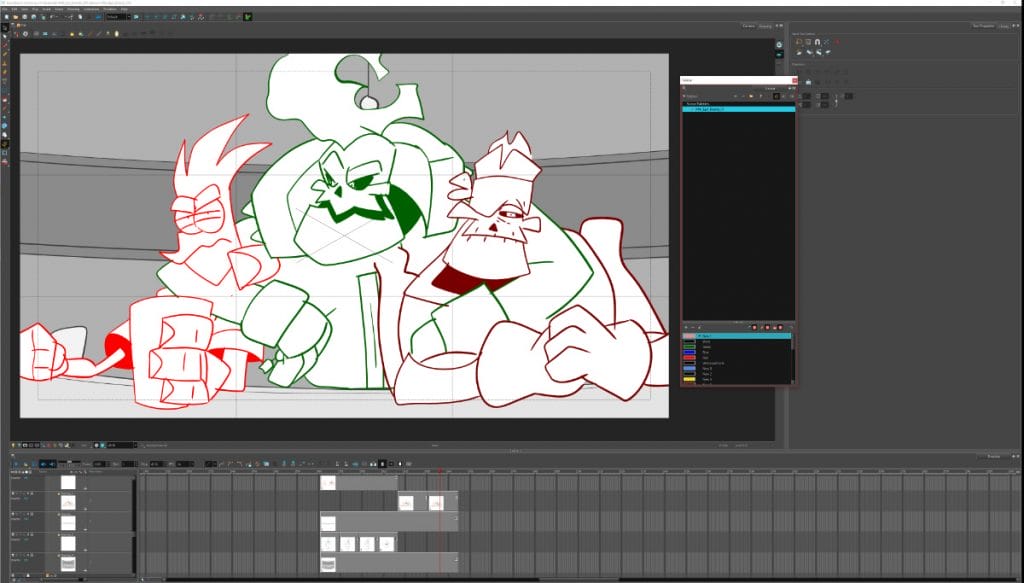
That’s really interesting. So you’re essentially storyboarding in Harmony?
Josh: Yep. In motion. It’s really strange, but for me, it works.
I find Harmony to be an incredibly versatile program. I do all the show’s compositing in Harmony as well, just by itself. I don’t have to take it to any other program. I just use Vegas to compile all the shots together and just render it. I do all the backgrounds in Harmony as well.
How do you feel Harmony holds up for all of the different aspects of the pipeline?
Josh: It does really well. It’s the most competent program I’ve used for animation, honestly. It’s just everything’s there.
It took me a while to get used to all the intricacies. For example, you’ve got the line art layer and then you’ve got the colour art layer to keep things separate. So it’s got a sublayer within itself. That’s very handy to keep things separated and to know where things are. It really helps with shading.
You got the peg system, which is really handy to use as well. And the palette system is one of my favorite things, being able to import a character’s palette and then link it to all the other scenes as well. So you can just instantly swap that colour in, swap it out. You don’t have to mess around with the color picker every single time. It’s already there.
My all-time favourite thing is the cutter tool. I absolutely love the cutter tool. It makes cleanup so fast. No longer do I have to zoom in and use the eraser tool to get it just right. Just cut those lines there and bisect them there. Snip, snip, done. Instant. It’s beautiful.
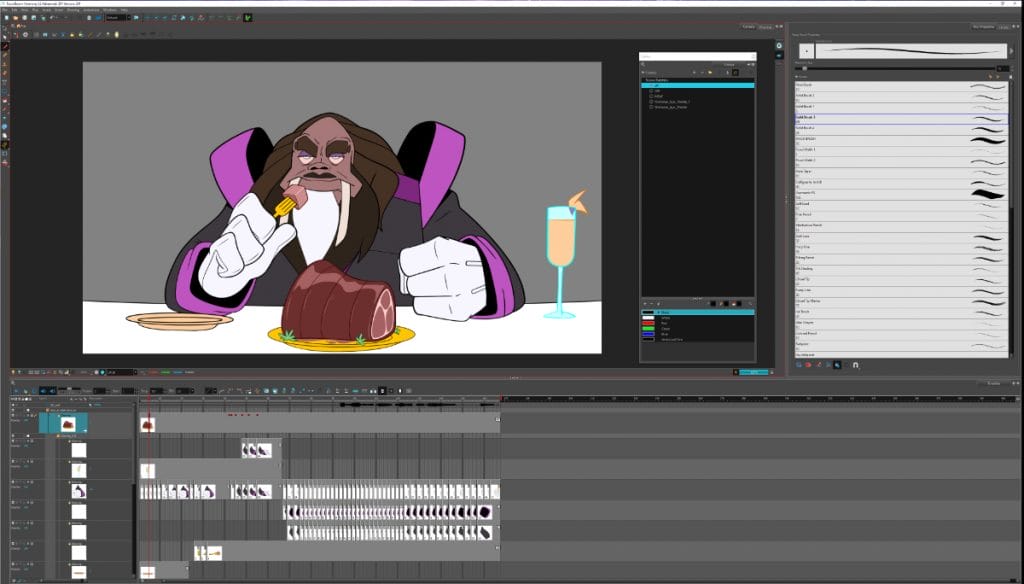
You have three episodes of Monkey Wrench up on YouTube so far. How’s production on Episode 4 going?
Josh: That one’s 33 minutes long. They keep getting longer. It took us a while to get it written because it just wasn’t coming out right. But we’ve been in production about four months now, and we’re about halfway through the animation. So I think it might be another six to seven months’ production on this one, maybe three or four months left.
With each episode, we get a little more attention, a little more money to produce the next one. So it’s a very slow climb, but it seems to be picking up more and more, so I can hire more people .
I’d really like to be able to get a lot more support so I can have more people on full time, pay them by the week, by the hour. That would be amazing. That’s the goal.
Before the third episode came out, you posted on your Patreon, “Here’s hoping over the next few months, we can continue to grow and hit our first goal of $5,000 a month. And now you’ve reached that.
Josh: Yeah, it’s slowly going up. I’ve found whenever we release an episode, we get a big bump, then a slow trickle of people coming in.
And then when another episode comes up, we get another bump and it goes up. II do feel the pressure of these people paying me a lot of money a month to get this done. I don’t want to let them down. I want to keep on going and going, give them updates being like, “Hey, look, we’re working on it. Look, it’s actually happening.”
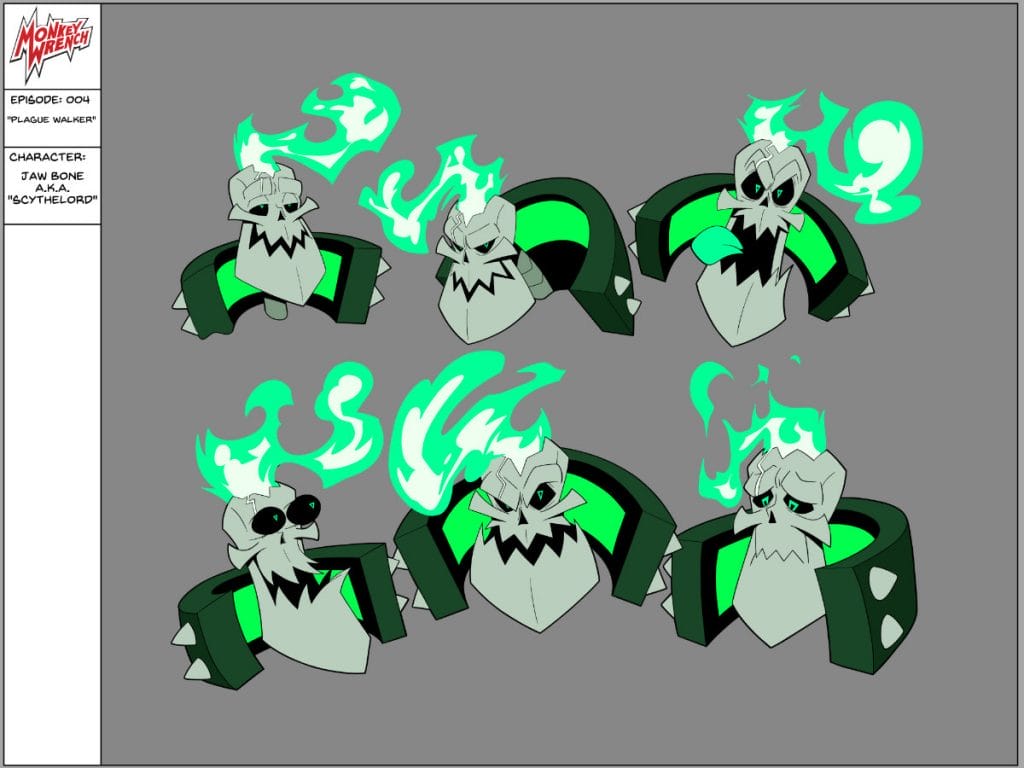
- The first four episodes of Monkey Wrench are now available to watch on YouTube. Josh Palmer can be found online at @Zeurel, and viewers can support the project on Patreon.
- Are you ready to get started on your independent production? Artists can download a free 21-day trial of Toon Boom Harmony.
The post Josh Palmer on the influences and community behind Monkey Wrench appeared first on Toon Boom Animation.
Courtesy: https://www.toonboom.com/josh-palmer-on-the-influences-and-community-behind-monkey-wrench






